Reid & Sigrist Ltd. Cameras 1947-1964
A Description of Reid Cameras Commercialized 1951 to 1964
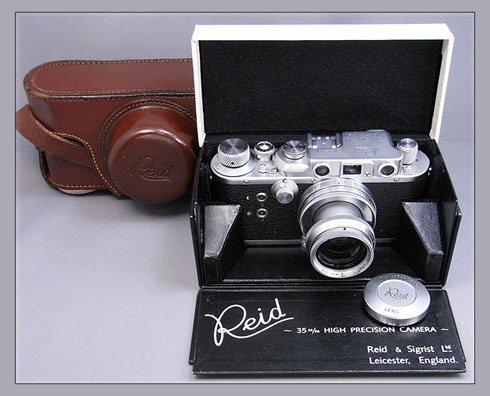
Display of the Reid & Sigrist Reid III camera
Reid & Sigrist and the development of the Reid camera line
Reid & Sigrist was an English engineering company based in Leicester in the Midlands of England. Initially it manufactured aircraft instrumentation and later diversified into pilot flight training equipment and aircraft equipment design. During World War II, the company was occupied in repairing, rebuilding and converting warplanes. After World War II, Reid & Sigrist diversified into the production of optical instruments and cameras.
Reid & Sigrist development of Reid cameras
In 1945, Britain obtained plans for Leica camera design from the E. Leitz factory in the zone of Germany occuptied by the British. German patents had been appropriated by the Allies on the beginning of the war with Germany. Then in July 1946, at an international conference in London, 12 Allied countries agreed that all German patents would be open to royalty-free license as part of war reparations. 11 The British intelligence service also left the Leica factory in Wetzlar, Germany with a complete set of microfilm plans for the pre-war IIIb and the later IIIc. As a result, Britain had both the plans and the intellectual property rights to produce cameras base on E. Leitz/Leica technology.
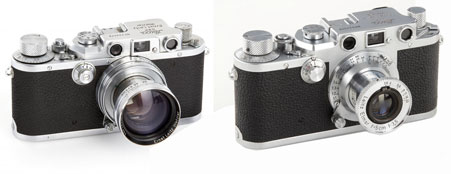
(l) the Leica IIIb (r) the Leica IIIc
Following the war, the British army contracted with Reid & Sigrist, who had been active in design and construction of aircraft instruments to produce a 35mm camera. Reid & Sigrist decided to make a version of the Leica IIIb, duplicating the M39 Leica camera lens thread mount, and slightly adapting other features according to its assembly needs.
After several years of development, the first Reid camera, the Reid III was introduced in 1951. The resulting camera was of high quality and finish, but also of high cost. The initial Reid III was more expensive than an imported Leica IIIf, even with a UK import duty of 25%.
Reid & Sigrist was purchased by Decca in 1954. Decca was active in aircraft instrumentation, being a leader in radar development in World War II. Under Decca, Reid & Sigrist continued with the development and production of the Reid rangefinder camera range.
Reid III
The Reid III, introduced in 1951 was produced in approximately 1600 civilian models and 700 military cameras until production was suspended in 1964. An initial version had flashbulb synchronization, with a jack on the camera front. By 1953, the Reid III included electronic strobe flash synchronization, with two connector jacks on the camera front.
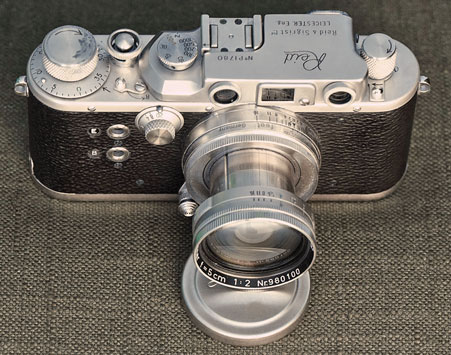
a Reid III fitted with a Leica Summitar 50mm f2.0 lens
Reid I
The Reid I was a simplified version of the Reid III. It had no rangefinder and was without slow speeds. The Reid I began distribution in 1958, with production of approximately 500 units, mainly to the British military.
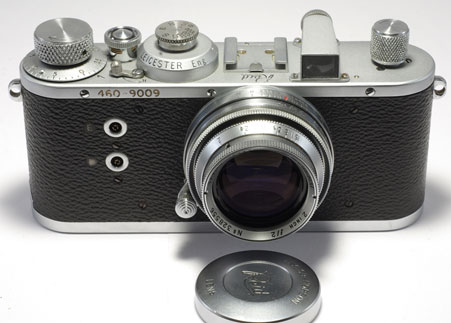
the Reid I in a version produced for the British army
"Reid II"
The camera sometimes called a "Reid II" was a model or prototype of about 1959, similar to the Reid III, but without slow shutter speeds. It was not commercialized.
Lenses for Reid cameras
The Reid camera used a M39 camera mount that was identical to the Leitz M39 Leica screw mount. Sourcing domestically, it fitted its cameras with a Taylor-Hobson Anastigmat 2 inch f2.0 lens in a collapsible barrel. Taylor-Hobson was a small but long-established lens manufacturer located in the same town as Reid & Sigrist: Leicester in the Midlands.
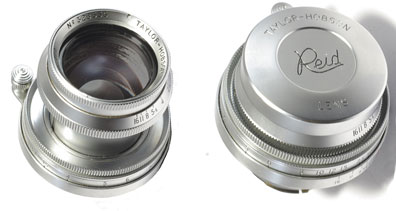
a Taylor-Hobson 2 inch f2.0 supplied with the Reid III
Reid Camera Production 1951-1964
When Reid & Sigrist ended production of Reid cameras in 1964, the company had produced between 2,800 to 2,900 units in the Reid III and Reid I. These cameras were very well made and precision products. They were among the best-made rangefinder cameras in the 1950s, and were not inferior in this respect with Leica construction. The Reid weakness was in their high cost of an essentially hand-crafted instrument, and also in their lack of effective commercial distribution. They are now esteemed collector's items for those interested in 35mm cameras of that era.
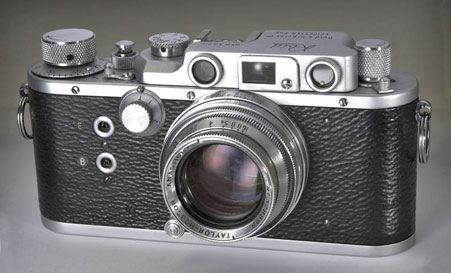
a beautifully crafted Reid III camera of the mid-1950s
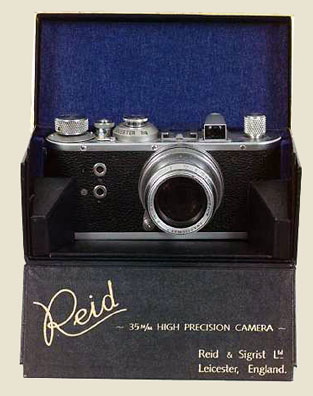
Display of the Reid & Sigrist Reid I camera
You can click on the links in the table below to consult other pages of the canonrangfinder.org site.
| Navigation: Click Below to Jump to Desired Subject Page | ||
|---|---|---|
| Canon Rangefinder Cameras - 1 | Canon Rangefinder Cameras - 2 | Canon Rangefinder Lenses |
| Canon S | Canon IVSB2 | Canon 19mm |
| Canon J | Canon IIS2, IID2, IIF2 | Canon 25mm |
| Canon NS | Canon VT, Canon L2 | Canon 28mm |
| Canon JS | Canon L1, L3 | Canon 35mm |
| Canon J-II | Canon VT Deluxe | Nikkor 50mm |
| Canon S-II | Canon VL, VL2 | Canon 50mm |
| Canon IIB | Canon VI-L, VI-T | Canon 85mm |
| Canon III, IIC, IV | Canon P | Canon 100mm |
| Canon IIIA, IVF, IVS | Canon 7 | Canon 135mm |
| Canon IIA, IID, IID1 | Canon 7s | Canon 200mm-1000mm |
| Canon IVSB | Minolta Rangefinders | Minolta Lenses |
| Canon IIF, IIS | Other Rangefinders | other M39 lenses |
| Go to canonrangefinder.com home page | ||
Any additions or corrections to these pages would be welcome simply by contacting this site as shown at the foot of this page .
Footnotes:
1 Dechert, Peter. Canon Rangefinder Cameras 1933-1968. Hove Collectors Books. West Sussex, United Kingdom. 1985. ISBN 0-906447-30-5.
Peter Dechert's book is the most important expert source of information regarding Canon Rangefinder Cameras.
2 Kitchingman, Peter. Canon M39 Rangefinder Lenses 1939-1971. A Collector's Guide. Published by Peter Kitchingman. Perth, Australia. 2008. ISBN 978-0-646-48144-9.
Peter Kitchingman's book is the definitive study of the more than three decades of M39 format camera lenses developed for Canon Rangefinder Cameras.
3 Nostalgic Canon Camera Book. 懐かしいキヤノン EI Publishing Co. Ltd. Tokyo, Japan. June 2003.
Peter Kitchingman's book is the definitive study of the more than three decades of M39 format camera lenses developed for Canon Rangefinder Cameras.
4 "Canon Camera Museum" history website. https://global.canon/en/c-museum/history/ published by Canon, Inc. accessed in 2019.
5 Rajner, Hans P. (author), John Wade (editor). Leica Copies. Classic Collections Publications. London, UK. ISBN 13: 9781874485056
Hans P. Rajner's book is an excellently detailed and carefully researched study of camera from around the world which used the Leica M39 lens mount and the same lens to film plane distance.
7 Dechert, Peter. Canon Single Lens Reflex Cameras 1959-1991. Historical Camera Publications. Yakima, Washington. 1992. ISBN 1-879561-04-2.
8 Tomlinson, Shawn M. The Film Photography Book. Lulu Pulbications. 2016. ISBN: 9781365263972
9 Sartorius., Ghester. Identifying Leica Lenses. Classic Camera 19. Tokyo, Japan. 2001. ISBN 4-257-12029-0
10 website http://www.nicovandijk.net/rflensmatrix.htm consulted 2019.
11 O'Reagan, Douglas M. Allied Exploitation of German Science after World War II. Johns Hopkins University Press. Baltimore, Maryland. 2019. ISBN 9781421428888
12 website www.canonrangefinder.servehttp.com consulted 2008.
13 Minolta expert Andrea Aprà has posted information on minoltarangefinders group and other groups and further detailed information by email. (thanks Andrea !)
14 website http://www.collection-appareils.fr/objectifs/ consulted 2019.
If you have any comments or questions about this Canon Rangefinder site, please e-mail me (Larry Huffman) at e-mail address: [email protected]